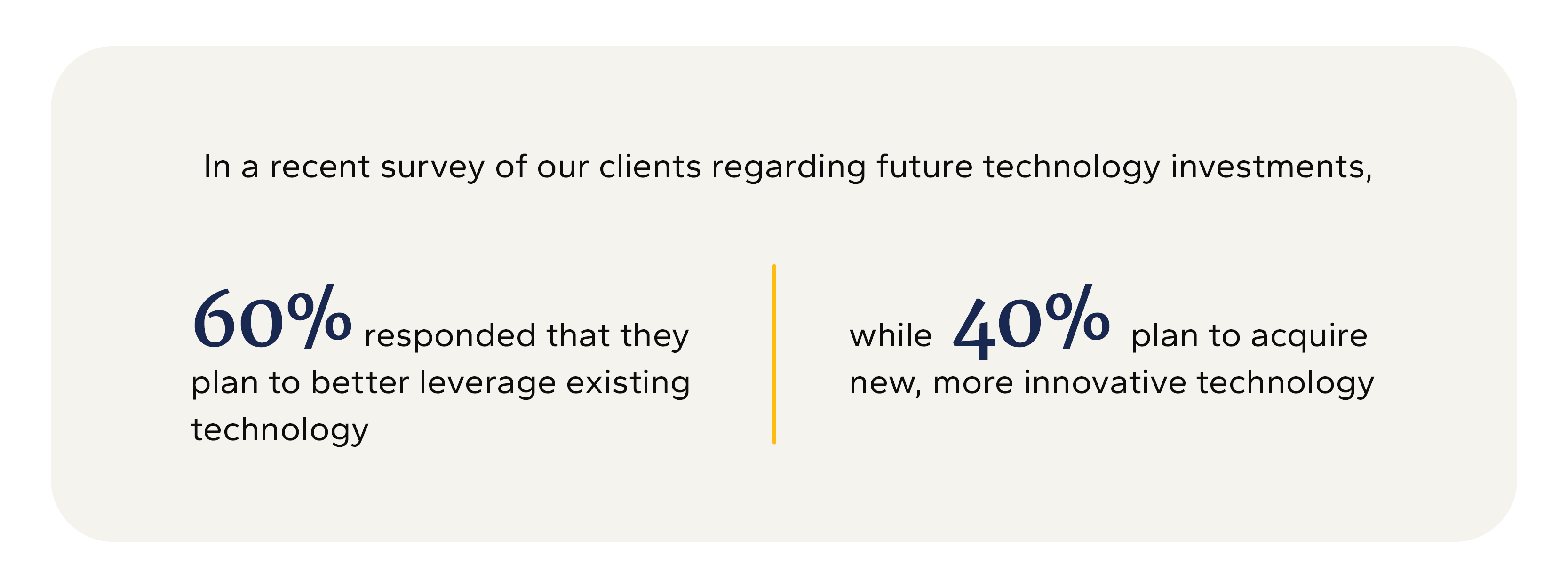Key Takeaways
- The two approaches to investing in technology are leveraging existing technology and investing in new technology.
- Any technology investment strategy should seek to align technology with the overall business strategy.
- Executive support and organization-wide communication creates trust and builds momentum.
There is no room in the current business landscape for standing still. In fact, nearly 80% of organizations need to adapt every 2-5 years. But agility means more than trying to solve challenges by introducing new solutions. A strategic digital roadmap can help you create a high-impact technology investment strategy that maximizes your investments and helps you meet your overall business objectives.
The Two Approaches to Technology Investment
There are two technology investment strategies: either you already have all the technology you need but struggle to capitalize on it, or you have gaps in your current tech stack which need to be filled through new investments.

The direction you choose depends on the current challenges and long-term goals of your organization.
Leveraging Existing Technology
By aligning your existing technology with your business objectives and streamlining your business processes, you can maximize your existing technology. Optimizing the technology you’ve already invested in provides an opportunity to support organizational growth, create long-term alignment between business and technology strategies, and maintain security.
Take a thorough inventory of all your technology, asking yourself:
- Are there any overlaps in the purpose or functionality of our tools?
- Are there any functions or capabilities in our current technology we are not taking advantage of?
- Are there any tools that we no longer need? (Remember, any cost savings from greater efficiency can be spent on future technology investments).
Investing in New Technologies
When legacy systems are no longer supported with updates — or no longer support your growing organization — it’s time to investment in new technology. This is especially likely if your organization is expanding, as your systems and processes will need to operate at peak capacity to support that growth. Identifying your technology gaps will help you create a better solution for the future.
Consider the following:
- What information or tech stacks are stuck in silos?
- Are there any manual processes that could be performed more efficiently using technology?
- Are any departments using different tools to accomplish the same tasks?
Overcoming Roadblocks to Innovation
Developing a high-impact digital investment strategy is essential for the continued growth and success of your organization, but it will not be without obstacles. Understanding and preparing for these roadblocks will make your digital initiatives run more smoothly and be more successful.
Lack of Leadership Support
Leadership support is critical when proposing an organization-wide change. To improve your odds of obtaining executive support, be prepared to explain the “why” behind the need for technology investment. Data is key when persuading senior decision makers, so take the time to prepare a cost-benefit assessment to show the ROI and its impact on the bottom line.
Lack of Change Management
Without a well-coordinated implementation strategy, digital initiatives can be quickly derailed. Make sure you have a steering group committee with members from different key functions. You’ll find that holding regular meetings and creating a shared tracking system will help keep everyone updated.
Only 34% of change initiatives are a success. Projects with change management are six times more likely to succeed.
In the pre-implementation phase, identify all end-users and poll them as to what their job pain points are, as well as what they like and don’t like. Use that information to create a new way to make their jobs easier. This action can underscore the positive impacts of the change while building the momentum you need to get wider acceptance and cooperation throughout your organization.
Lack of Transparency
When discussing changes to processes or employee roles, keep the human impact in mind. A lack of information may lead people to believe the worst and become defensive. If someone has been running reports in a certain way for many years and they are suddenly told that their process has been changed, they may resist the shift. Being transparent about upcoming changes before they occur, explaining the “why” behind the change, and having empathy and compassion for those who resist will help maintain morale during large-scale changes.
Embarking on Your Digital Journey
While a patchwork approach to technology investment may suffice in the short term, it is not sustainable in the long run. A successfully implemented technology investment strategy will allow your organization to thrive in today’s digital landscape.
To learn more about this topic, don’t miss this webinar featuring two Eide Bailly clients who have recently undergone digital transformation journeys. You’ll hear all about their experiences, the challenges they encountered, and the steps they took to ensure a seamless and successful transformation.
Defining a High-Impact Technology Investment Strategy

Strategy and Digital Future
Create a lasting digital future for your organization.



